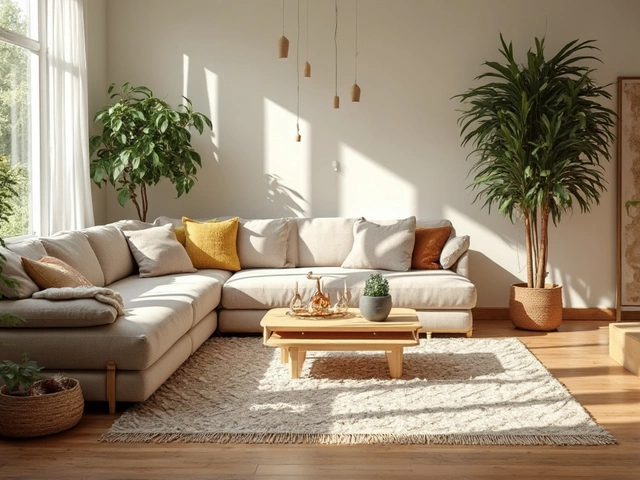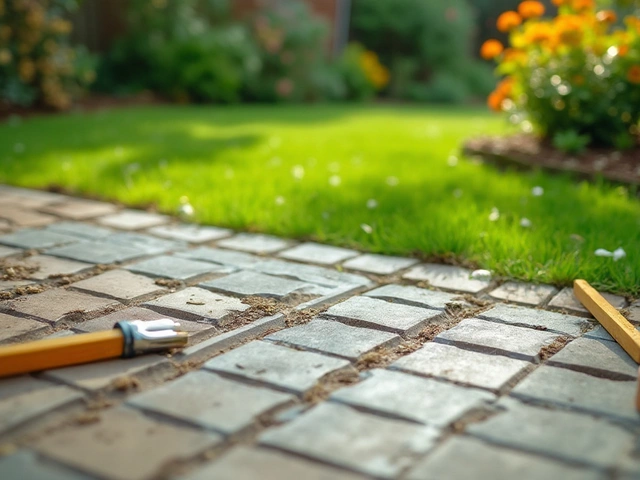
Reach over from your bed and grab your phone without knocking over your water? That’s the dream, right? The thing is, placing your nightstand too close or too far can mess with how comfortable your bedroom feels.
Most people don’t realize there’s a sweet spot. Designers and sleep experts usually suggest keeping your nightstand about 2 to 4 inches away from the side of your mattress. This gap stops your knuckles from bumping into the furniture when you toss and turn, but keeps your phone, lamp, or water glass easy to grab—no ninja moves required.
If you leave too much space, your midnight reach turns into a full-body stretch. Too close, and you’ll wake up every time your arm slides off the edge of the bed. Getting the distance right just makes life easier. And hey, if you have little ones like Aldric trying to sneak in at night, you don’t want any sharp corners in their way. There’s more to consider, but nailing the basic distance is the first step.
- The Ideal Distance Explained
- Why Spacing Matters for Comfort
- Common Nightstand Sizes
- Making Room in Small Spaces
- Tips for Families and Safety
The Ideal Distance Explained
So, exactly where should your nightstand go? There's actually a simple guideline most pros follow: the front edge of your nightstand should line up pretty close to the height of your mattress, and the side should sit about 2 to 4 inches from the bed. This distance isn't random. It lets you reach what you need without awkward leaning or risking a banged-up elbow in the dark.
This sweet spot works almost everywhere. Here’s why: experts say that when your nightstand sits within that 2- to 4-inch gap, you won’t trap your bedsheets, but you’ll also avoid dropping your phone into an annoying crack. A survey by the National Sleep Foundation found nearly 70% of people keep their phone on the bedside table—so getting the placement right makes quality-of-life difference.
If you're wondering about the numbers, check out this quick comparison:
| Distance from Bed | Pros | Cons |
|---|---|---|
| 0 inches (touching) | Zero risk of items falling in gap | No space for bedding, easily bumps mattress |
| 2-4 inches | Easy access, clean look, ideal spacing | Almost none if done right |
| 6+ inches | Extra space for cords or décor | Awkward reach, stuff may fall between |
Here's what to do:
- Align the top of your nightstand with the top of your mattress (or within two inches higher/lower).
- Measure 2 to 4 inches from the mattress’s edge to the nightstand and adjust from there—don’t just eyeball it.
- If you have less room, shoot for the narrow end of the range. If your space allows more wiggle room, try the wider end.
Following these simple steps with your nightstand placement can seriously upgrade both comfort and style in your bedroom.
Why Spacing Matters for Comfort
If you’ve ever knocked over your phone or hit your elbow in the middle of the night, you know a badly placed nightstand can ruin your vibe. It’s not just about looks—spacing actually affects how restful your bedroom feels and how easy it is to use your stuff.
Keeping your nightstand at the right spot makes life simpler. Think about it: Most people use their bedside table up to five times a night—for grabbing a glass of water, charging a phone, hitting the snooze button, or reaching for meds. If it’s awkwardly placed, half-asleep you will notice.
Having your nightstand placement just a few inches from the bed keeps essentials within arm’s reach, cuts down on fumbling, and stops accidents before they happen. This is especially true if you use a CPAP machine, white noise device, or keep prescription meds handy at night. According to a 2023 survey from a major home goods retailer, 58% of people said they kept at least three different items on their bedside table.
- Reduces the chance of spills and falls—especially with kids or pets in the house.
- Makes reaching for your alarm, lamp, or water much more comfortable.
- Lessens the risk of knocking over things in the dark (or half asleep).
Some folks also need space for medical needs at night, like glucose meters or inhalers, and putting those too far away just isn’t smart. On the flip side, cramming the table right up against the mattress makes it hard to change sheets and clean up dust bunnies.
| Problem | Nightstand Too Close | Nightstand Too Far |
|---|---|---|
| Reaching Drink | Elbow bumps, spills | Uncomfortable stretch |
| Plugging In Devices | Cords may get pinched | Some cords won't reach |
| Changing Sheets | Difficult | Easy |
| Visual Balance | Crowded look | Gaps look awkward |
If you’re not sure what feels right, try a little trial and error. Move your nightstand forward or back an inch every night for a week and see what’s easiest when you’re tired. Your comfort really is the main thing here—no fancy rules needed, just what works for you and your room.

Common Nightstand Sizes
It's wild how many options you see when shopping for a nightstand. You’ve got to match the height to your mattress, and then check the width so it fits that gap you left between bed and wall. The standard height for nightstands lands between 24 and 28 inches. Most beds—including ones with a box spring or thicker mattress—end up about 25 inches off the ground, so a nightstand close to this height just feels right. Anything too tall or too short can make your bedside setup awkward and uncomfortable.
Width is usually less important than height, but it matters way more if your bedroom’s tight on space. Most nightstands run between 18 and 22 inches wide. Double-check this if you’ve got a bulky bed frame or some funky wall angles. For depth, the usual range is 15 to 18 inches. That gives you enough surface for a lamp, a book, or a glass of water, but it’s not sticking out so far you bang your leg every morning.
- If you’ve got a queen or king bed, aim for nightstands at least 20 inches wide so they don’t look puny next to your bed.
- For twin or full beds, something smaller, maybe 16-18 inches wide, does the trick.
- Remember: it’s all about being able to reach your stuff easily, not just what looks good in furniture catalogs.
If you want to be extra practical, measure from your floor up to the top of your mattress, then look for a nightstand within an inch or two of that number. That way, your hand naturally lands where it should—right on top of your nightstand placement sweet spot.
Making Room in Small Spaces
Small bedrooms can make you rethink everything about nightstand placement. If you’re squeezing between the bed and the wall, or you’re just fed up with bumping your shin every morning, you’ve got options.
Forget the idea that a nightstand always has to be a bulky table—lots of folks are switching to more space-saving ideas. Floating shelves, narrow carts, even sturdy wall hooks can do the job without eating up precious inches on the floor. The trick is to pick something just big enough for your essentials: phone, glasses, lamp, maybe a book if you’re old school.
Don’t forget about height. Keep your nightstand surface roughly level with the top of your mattress. If it’s too low, you’ll fumble for your stuff; too high, and you’re at risk of knocking things over. Most modern nightstands range between 24 and 28 inches tall, but measure your bed—especially if you’ve got a thick mattress or a platform frame.
- Look for nightstands or shelves that are 12 to 16 inches wide—they fit in tight spots and still hold the basics.
- Floating shelves can give you all the storage without taking up floor space, and you set the exact height yourself.
- Skip the traditional lamp and use wall-mounted ones to keep your surface clear.
- If floor space is super tight, even a stack of sturdy books or a repurposed stool beats nothing.
Here’s a quick look at how nightstand width affects your usable surface in a small room:
| Nightstand Width | Surface Area (sq in) | Fits In Rooms This Wide |
|---|---|---|
| 12" | 144 | 7 ft or less |
| 14" | 168 | 7-8 ft |
| 16" | 192 | 8 ft or more |
If you’re battling clutter, go vertical—not wider. A small set of drawers or a shelf above the stand can hold extras (think chargers, chapstick, earplugs) without crowding your floor. When every inch counts, even small tweaks make a big difference.

Tips for Families and Safety
If you’ve got kids or pets around, it’s not just about style – it’s about making your room safe. Your nightstand placement can make a big difference in how accident-proof your space is, which is something most folks don’t think about until the LEGO hits the fan.
Start with the basics: skip sharp corners if you’ve got toddlers. Rounded-edge nightstands or corner guards can save a lot of tears (and your shins). My son Aldric once caught the edge of a table while running for a bedtime story – lesson learned the hard way. If you’re shopping for a new nightstand, look for models with soft-close drawers so little fingers don’t get squished.
Height is another biggie. Aim for a nightstand that's about the same height as your mattress, give or take an inch or two. Tipping hazards go up when a nightstand is way taller or when drawers are overloaded—especially with curious kids who might pull on them. There’s actual data from consumer safety agencies: the U.S. Consumer Product Safety Commission reports that tip-overs cause over 15,000 ER visits each year. Securing your nightstand to the wall with anti-tip hardware is a smart move, especially if you live in an area that gets earthquakes.
It helps to keep electrical cords out of sight and reach. Tuck away phone chargers and lamp cords so nobody trips. If you use outlet covers or cord organizers, it can prevent both burns and yanks. For nighttime visibility, try a small motion-sensor night light on or near your nightstand instead of a traditional lamp.
Here's a quick look at some features and habits that make a difference for families with kids:
| Safety Feature | Benefit |
|---|---|
| Rounded Corners | Lower risk of bumps and cuts |
| Soft-Close Drawers | Stop finger pinching |
| Anti-Tip Hardware | Prevents furniture falling accidents |
| Hidden Cords | Reduces tripping and electric shock risk |
| Night Lights | Prevents stumbling at night |
If you share your room with your kiddo, steer clear of glass tabletops or decorative hardware that could snag pajamas. Finally, continue the 2-4 inch gap with the nightstand – it’s wide enough for safety, but not so wide a curious little one could squeeze behind and get stuck. When in doubt, keep it simple and stable—your sleep (and sanity) will thank you.



